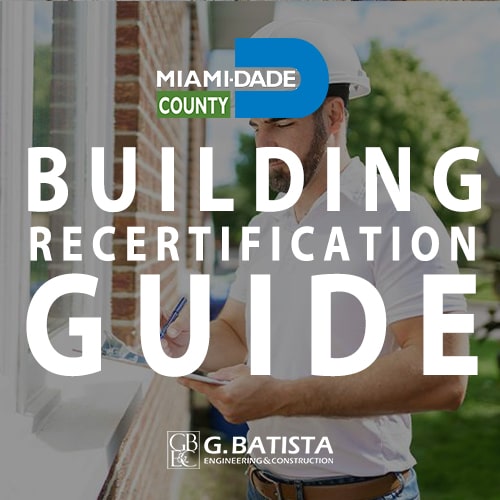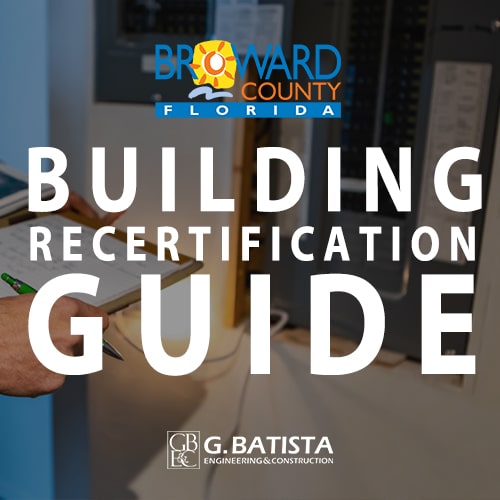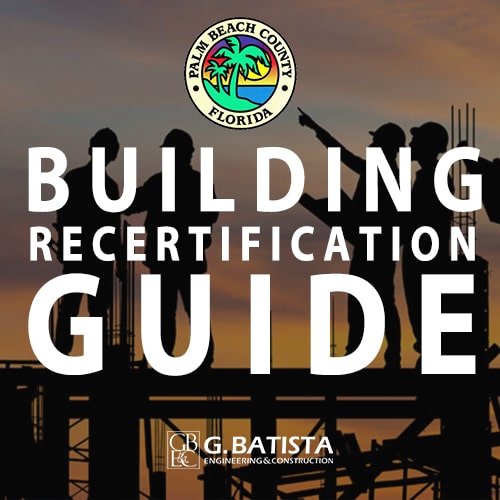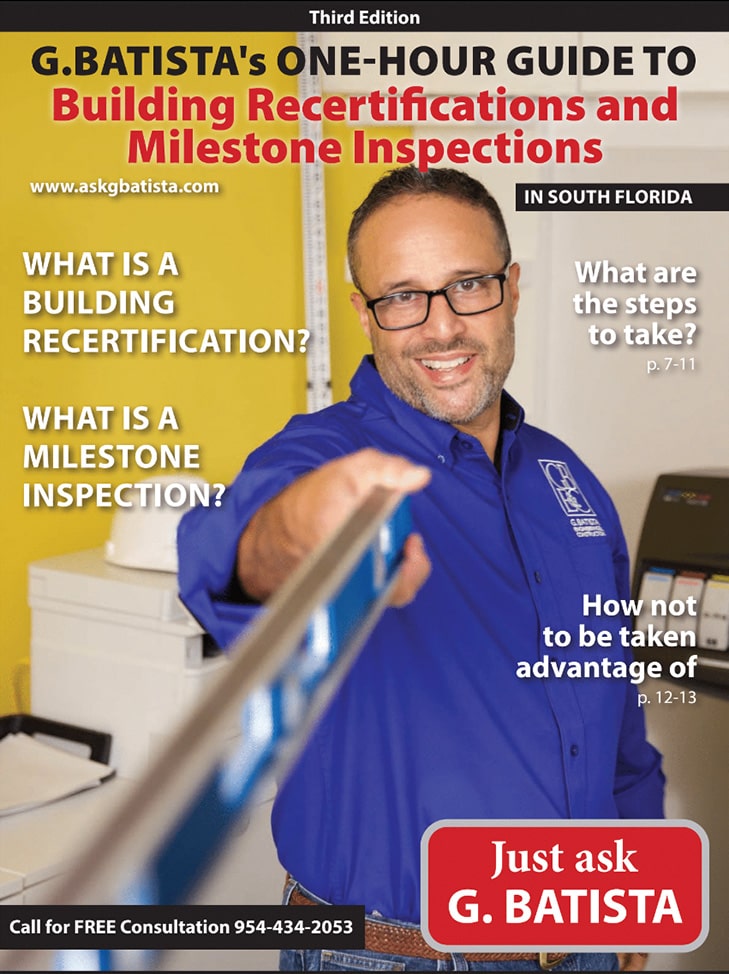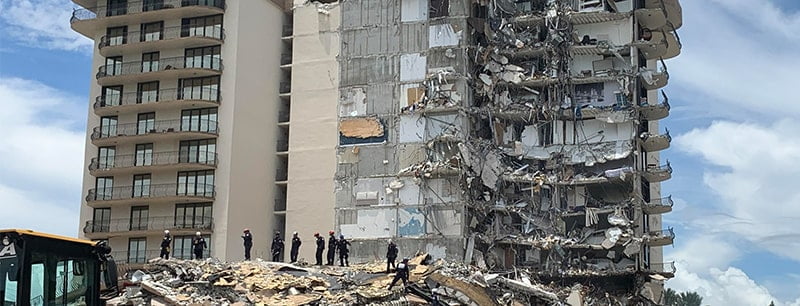
EVERYTHING YOU NEED TO KNOW ABOUT 40/50 YEAR RECERTIFICATIONS AND THE SURFSIDE BUILDING COLLAPSE
The collapse of the Surfside condo building has resulted in an upsurge of building enforcement action that was long overdue. The 40/50 year recertification process for buildings is intended to avoid a catastrophe like the one we witnessed. If you are a property owner, HOA member, building manager, or owner’s representative, the information we are about to share will help you understand and prepare for a 40/50 year recertification. Here at G. Batista Engineering & Construction, building safety is our mission. Our building inspectors are highly trained structural engineers who can help you overcome the challenge of these new Building Safety Inspections.
What is a 40/50 year recertification?
40 year certifications are a requirement whereby a building must have a licensed engineer conduct a thorough inspection to examine any potential safety or structural vulnerabilities. Any failure that can pose an immediate threat to the safety of a building’s occupants is documented in a report. Building owners or representatives must correct these issues in a timely fashion. This requirement is due 40 years after a building’s construction date and 10 years thereafter. A 50 year recertification refers to the recertification requirement after the initial 40 year mark, which is necessary at year 50.
What is included in a 40/50 year recertification?
The main components of a building that are generally inspected include the following:
- Exterior walls
- Roofing Systems
- Electrical systems
- Foundation
- Steel Framing of Building
- Floor Systems
- Windows
- Loading Conditions of Building
- Wood Framing
- Emergency Lighting
- Parking Lot Illumination
What Types of Buildings Are Required to have a 40/50 year recertification?
40/50 year recertifications apply to every building structure with the exceptions of single-family homes, duplexes, and properties that are less than 2,000 square feet or have an occupant load of 10 or less. In certain counties such as Broward, there are exceptions to buildings with less than 3,500 square feet as well as U.S. government or state government structures that are built on Indian reservations.
What changes can we expect after the Champlain Towers Surfside building collapse?
At this point in time, it’s difficult to say what changes to 40/50 year recertifications we can expect. However, we are seeing many cities looking to change the 40 year period to 30 years. There is also an understandable increased level of concern and caution from property owners, homeowner associations, and owner’s representatives. They are now being more proactive than ever about making sure that inspections are performed when required or when visible damage is prevalent such as cracks in concrete and spalling, conditions that previously were not given much attention to. The fact is, as engineers if we see a potential failure that is seriously putting people’s safety at risk, we are very diligent about documenting said issues and recommending corrective action. Immediate action is not always taken due to budget constraints or simply not wanting to inconvenience homeowners with construction repairs. The Surfside building collapse demonstrated what can happen if structural and concrete issues are not taken seriously. We live in South Florida and the ocean can wreak havoc on concrete. We must be proactive about keeping our buildings safe.
When should you prepare for a 40/50 year recertification?
Don’t wait until you receive notice from the county. At that point, you only have 90 days to show compliance. We recommend beginning the inspections 2 or 3 years prior to the 40 year birthday of the building’s construction. This should give you ample time to understand any potential failures that the building may need and budget for repairs if necessary.
What are some things that can be done to prepare for a 40/50 year recertification?
- Make sure that electrical outlets near bathrooms and sinks are GFCI-protected.
- A/C closets should not be used for storage.
- Electrical panels need to be labeled and there should not be any open slots.
- Roof annual maintenance is important. Schedule annual roofing inspections.
- Buildings should be professionally painted and caulked every 7 to 10 years and pressure washed at a minimum every 2 years. If it’s a property near saltwater, the maintenance should be more often.
- Ensure that the parking lot has plenty of illumination. Dark parking lots can pose a lot of dangers.
How much can corrections after the 40/50 year inspection be?
Obviously, it varies from building to building. Properties that are well-maintained may just need some minor repairs such as paint. Buildings that have not been properly maintained over the years may need more drastic repairs such as roof replacement or extensive concrete restoration which can take several months to remedy. For this reason, we recommend that if you see any signs of cracking in concrete or spalling, get it looked at right away. Spalling refers to the rusting and corrosion of the steel reinforcement that is found inside concrete structures. When this is exposed it is a sign of structural vulnerability. If addressed immediately, the repair can be minor. If left exposed for a long time, it could mean a complete replacement of the bigger structure. We have seen instances where spalling in parking garages was neglected for so long, that our only option was to replace the entire floor structure.
Do I still need to get a 40/50 year inspection if a notice is not received?
Obviously, it varies from building to building. Properties that are well-maintained may just need some minor repairs such as paint. Buildings that have not been properly maintained over the years may need more drastic repairs such as roof replacement or extensive concrete restoration which can take several months to remedy. For this reason, we recommend that if you see any signs of cracking in concrete or spalling, get it looked at right away. Spalling refers to the rusting and corrosion of the steel reinforcement that is found inside concrete structures. When this is exposed it is a sign of structural vulnerability. If addressed immediately, the repair can be minor. If left exposed for a long time, it could mean a complete replacement of the bigger structure. We have seen instances where spalling in parking garages was neglected for so long, that our only option was to replace the entire floor structure.
Which types of properties are most vulnerable to issues?
Obviously, it varies from building to building. Properties that are well-maintained may just need some minor repairs such as paint. Buildings that have not been properly maintained over the years may need more drastic repairs such as roof replacement or extensive concrete restoration which can take several months to remedy. For this reason, we recommend that if you see any signs of cracking in concrete or spalling, get it looked at right away. Spalling refers to the rusting and corrosion of the steel reinforcement that is found inside concrete structures. When this is exposed it is a sign of structural vulnerability. If addressed immediately, the repair can be minor. If left exposed for a long time, it could mean a complete replacement of the bigger structure. We have seen instances where spalling in parking garages was neglected for so long, that our only option was to replace the entire floor structure.
What happens if I do not submit the 40/50 year recertification report on time?
Failure to comply with this requirement will result is the issuance of a Civil Notice from your county and this matter is referred to the Unsafe Structures department which can take immediate action including shutting your building down and requiring it to be vacated. You can also expect fines over $10,000 along with enforcement proceedings costs. In rare cases, your building may even need to be demolished. Bottom line, take these 40/50 year recertification requirements seriously.

